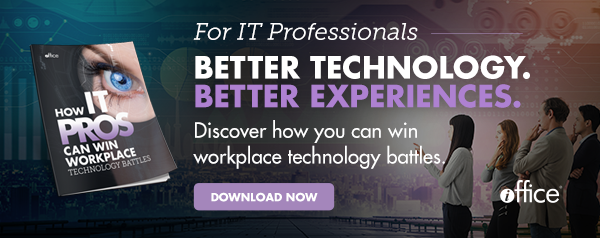Does Your Digital Workplace Have The Right Technology?


Within the past few years, the workplace stopped being a “where” and instead became a “how.” Work can be done anywhere—as long as employees have the right technology.
In the report, The digital workplace: Think, share, do, the experts at Deloitte discuss how leading businesses are transforming the employee experience through the digital workplace.
The report breaks down the digital workplace into four layers:
1. Use: collaborate, communicate, connect
2. Technology: the digital toolbox
3. Control: governance, risk and compliance
4. Business drivers: measurable business value
In this article, we discuss the second item in that list: technology. Here are the eight categories of technology Deloitte says should be in every organization’s digital workplace toolbox.
8 Digital Workplace Technology Tools
1. Business Applications
Purpose: To give employees remote access to self-service solutions
Examples:
● HR systems
● Enterprise Resource Planning (ERP)
● Customer Relationship Management (CRM)
Business softwares cannot live on a single server, usable only by on-site employees. Your workforce needs SaaS solutions that they can access on-demand wherever they are.
2. Technology That Enhances Collaboration
Purpose: To enable employees to work together as teams, regardless of physical location
Examples:
● Team collaboration software
● Knowledge base
● Video conferencing software
Collaboration moves organizations away from “too many cooks in the kitchen” and toward “two heads are better than one.” And a silly thing like being several thousand miles apart can’t be the reason employees aren’t able to work together as a team.
3. Communication Tools
Purpose: To promote information sharing and knowledge transfer between employees
Examples:
● Employee intranet
● Enterprise social technologies
● Knowledge management software
Every employee has different levels of expertise, experience across various fields and unique points of view. Employees must have the ability to share that expertise, that experience and those points of view with the rest of the workforce.
4. Crowdsourcing Tools
Purpose: Supports gathering of feedback and suggestions from employees
Examples:
● Idea and innovation management software
● Employee surveys
● Online discussion forums
You send customers surveys and you invite them to share their opinions on your social platforms — all to find ways to improve your product or service. Do the same thing for your workforce so you can make decisions about improving the digital workplace — and, in turn, the employee experience — based on actual feedback, not assumptions.
5. Connectivity
Purpose: Helps employees locate colleagues and meeting spaces across organization
Examples:
● Wayfinding
● Digital signage
● Kiosks
Connected employees are more productive and more engaged. But employees can’t be connected if they can’t find one another or a place to meet.
6. Messaging
Purpose: Provides employees with fast, efficient way to communicate with colleagues
Examples:
● Instant messaging
● Mobile messaging
[More: 12 Slack Integrations That Enhance the Employee Experience]
We all have our preferred methods of communication. And for younger generations, talking on the phone is becoming less and less popular. Ensure the workforce has robust messaging platforms with the kinds of features that facilitate open communication.
7. Workplace Mobility Tools
Purpose: Allows employees to work remotely by giving them access to necessary tools away from the office
Examples:
● Laptop
● Tablet
● Smartphone
A mobile workforce needs technologies that travel. Not only that, these technologies must be a blessing, not a burden. In other words, the laptop or tablet or smartphone you give the workforce must be powerful and fast. There’s no sense in carrying around a computer that’s lacking in features or speed.
8. Productivity
Purpose: Empowers employees to complete their jobs efficiently
Examples:
● Project management software
● Cloud-based file sharing
● To-do list software
The primary goal of building the digital workplace is to increase productivity. Don’t hinder the productivity and efficiency of your workforce by forcing them to complete tasks without the right software and equipment.
Connecting The Dots Within Your Digital Workplace
Even if you can claim your workforce has the latest and greatest version of every technology on this list, if they all exist independently, you’re likely doing more harm than good. None of these technologies can be siloed in a true digital workplace. Instead, they need to be integrated via an employee experience solution platform like iOFFICE Hummingbird.
Hummingbird “hovers” over your existing workplace management systems, connecting it to user-friendly interfaces employees can access anywhere.
Using their desktop, smartphone app or kiosk, employees can easily find people, reserve space, request services and more. To learn more about how Hummingbird helps IT professionals streamline workplace technology, check out this helpful resource.
